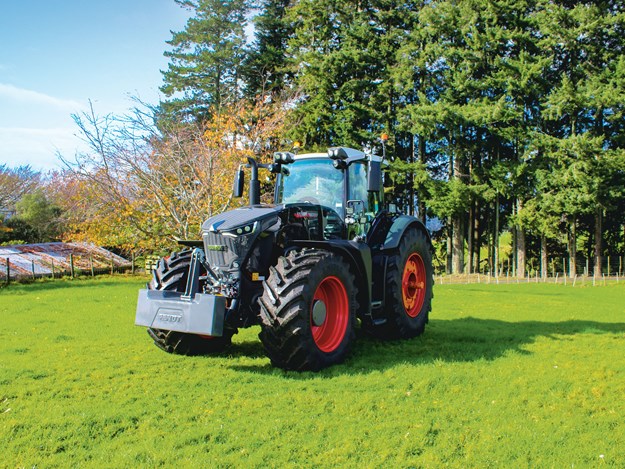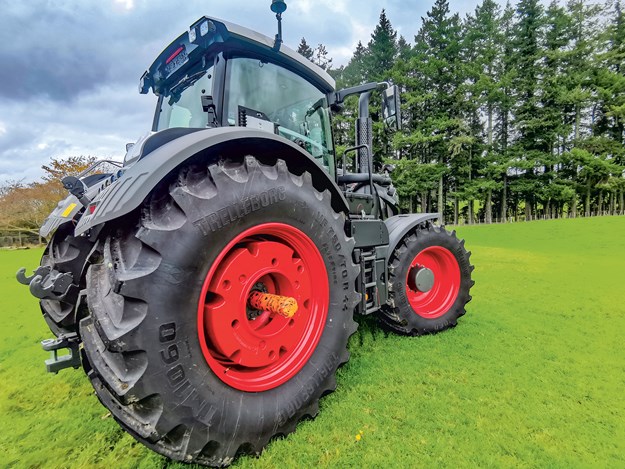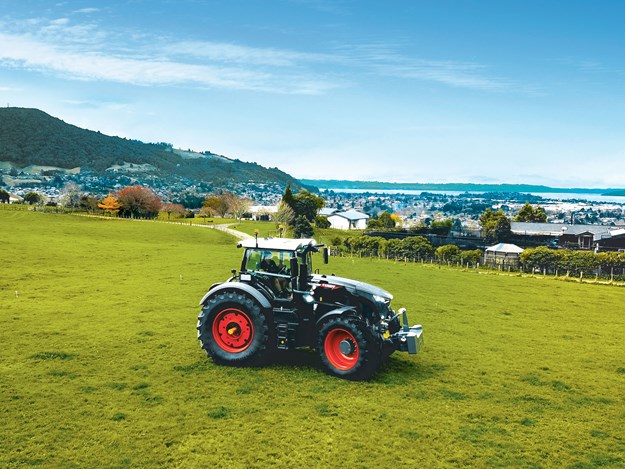Review: Fendt 933 Gen 7
One of the first of its kind in the country, Farm Trader managed to get behind the wheel of the newly landed Fendt 933 Gen 7 Series
 |
|
The impressive black Fendt 933 Gen 7 is the pride of the fleet for Te Puke contractor Darryl Isaac
|
While the Fendt 900 Gen 6 series has been working in the country for the last few years and has become a well-recognised contender in the New Zealand machinery market, this newer Gen 7 model brings some added punch to an already strong line-up.
 |
|
Night becomes day with 360-degree LED lights
|
The Gen 6 Series showcased some massive changes for Fendt, incorporating an all-new driveline as well as a multitude of other features. Obviously, the Gen 7 carries on with this commitment to innovation, and while there aren’t too many drastic changes at first glance, the Gen 7 900 does sport an impressive cab revamp.
While Fendt is smart enough to keep all of its cab layouts familiar throughout its models, this 933 sports the FendtOne cab design and operator control panel, aligning with the latest 700 Series tractor, which Farm Trader had a look at a few months ago.
This smart technology has made its way into the 900s, so we jumped at the opportunity to have a first-hand look at this early arrival To New Zealand. Also, it has to be said that the black livery does add an extra element of glamour.
Specs
Fendt was a pioneer in CVT technology in tractors. Running with the Vario name, all Fendt tractors feature a vario transmission of some kind. The 900 Series features the same TA400 transmission as the 1000 series. This transmission incorporates an additional motor to power the front wheels. Active all-wheel drive is a good term for this, as the tractor can recognise what’s needed to perform at its peak.
 |
|
Large battery box door swings open for easy access
|
For example, when turning, it will pull the front end around minimising the turning circle by up to just over a metre. And when the front or rear starts to slip, an intelligent clutch will engage to send extra torque to the wheels that aren’t slipping. This does, however, remove the four-wheel-drive option for the operator, which in the early days was met with some mixed responses. It’s a substantial change to lose a four-wheel-drive button and initially made some operators uneasy. However, once behind the wheel, you’ll realise that it only has positive effects, allowing the tractor to travel further in less-than-ideal circumstances.
The Gen 6 900 series saw the introduction of the nine-litre MAN engine, which continues into the Gen 7 Series. Being part of the Fendt low engine speed concept, it can achieve greater torque at lower RPM.
The mighty 933 we tested has a rated engine speed of 1700 and a max torque of 1650Nm. This is fed by a 625-litre fuel tank alongside a 70-litre AdBlue tank to help extend those long working days. The rest of the range has the same engine and tank capacity, but the max torque and power change depends on the model size. The 930, 936, 939, and range-topping 942 have 296hp/1550Nm, 350hp/1750Nm, 385hp/1850Nm, and 415hp/1970Nm respectively. These tractors have an impressive torque rating achieved at relatively low rpm, in turn, saving fuel, minimising wear, and reducing running costs – all hugely important for farmers and contractors today.
 |
|
Bonnet swings up clear of the radiators
|
The Fendt 900 Series has an array of hydraulic options available to suit the needs of every application. The standard pump size has 165 litres per minute capacity. If that doesn’t quite cut the mustard for your needs, a 220 litres per minute pump is an optional extra.
If your job is extremely demanding on the hydraulics, a 220 plus 210-litre pump set-up is available totalling 430 litres per minute. With hydraulic capacity like that, the largest scoops and other hydraulic demanding jobs will be achieved without issue.
A feature that all Fendt models have (which I believe should be standard on every tractor) is separate hydraulic tanks to the transmission. This eliminates any contamination and allows the transmission to run in clean oil suited to its specific requirements.
Tech
Fendt has excelled in the space of market-leading technology for a number of years. The Gen 7 900 Series extends on this with multiple information terminals that can display an array of functions. The armrest terminal has been completely re-designed, and the result is a large, clear 12-inch touchscreen that improves on operator useability over the earlier models. This terminal has the access to configure and control all tractor functions such as hydraulics, transmission, headland management, ISOBUS, plus some comfort features.

The screen layout is split into a maximum of six configurable sections to show all the essentials for the task at hand. This terminal has multiple pages, and each can be accessed with a simple swipe. This sort of set-up allows for the operator to customise their screen to show exactly what needs to be seen.
A point that has been improved on from earlier models is the ability to adjust tractor hydraulics or linkage settings. For example, this can be done from any part of the screen or on any page, further increasing the useability of the machine, plus making it easier for different operators to get in and change settings. The terminal also has the ability to save operator set-ups. This allows the same tractor to be used between different operators, with each having their personal setting loaded at the push of a button. I find this an excellent feature, as there aren’t many things worse than someone getting in your tractor, changing half the settings and leaving a convoluted mess to sort out when you get back to it. Fendt has really put the operator in an optimal position with this generation of tractors.
Sometimes, one screen doesn’t quite cut it if numerous things need to be monitored. This is where the Gen 7 really struts its stuff. A second optional terminal is mounted in the roof and drops out at a light push. This terminal has the same functions as the armrest and data is transferred between the two in real-time.
 |
|
Dash has plenty of pages to display; here we show the current assigned buttons
|
Providing an uncluttered cab, the operator has the choice of where to run the ISOBUS, cameras, guidance, and machine monitoring functions for optimal comfort. The FendtOne set-up really has all the bases covered for the most technical of tasks in today’s farming world. Being fully ISOBUS-compatible, Fendt has always had an outstanding ISOBUS integration into their tractors, and the latest 900 is no different.
The available functions can be assigned to most buttons on the handpiece and their three-level joystick can house up to 27 functions. Also, being TIM-compatible allows the implement to control certain tractor functions and work within its range, thus reducing extra stress on the operator.
Another change to this new operating environment that cannot be missed is the new 10.1-inch dashboard. Most manufacturers are switching to a screen-style dashboard and Fendt is no different. This display-only screen has multiple pages for the operator to scroll through with the push dial launchpad. It can also be set to show the functions that you’re currently using, such as GPS guidance and remote valves all the way down to the radio and the air con settings, further enhancing the operator atmosphere.
 |
|
Standing staunch with 1800kg weight pack
|
The level of tech available on the order sheet is impressive. Full auto-guidance and section and rate control are available through Trimble systems. A point that I find superior on the Fendt machines is that the GPS units are found inside the roof hatch and are only accessible from the inside. This keeps the costly unit protected from the elements while also protecting it from theft.
VarioGrip is also an option available on these tractors. This is Fendt’s version of central tyre inflation and can be set up to deflate for field mode and pump up for road transport. Combined with Fendt’s grip assist, tyre life is significantly improved, not to mention how much more productive it is in the field through minimising the wheel slip.
Operator comfort
The Fendt 933 we had to test looked wicked in its black paint job. From the outside, the cab on the Gen 7 looks much the same, but it doesn’t take long to realise where the changes on the inside are.
Multiple screens are placed strategically around the cab, and it isn’t until the tractor is started that they release its full potential. The armrest is part of the Fendt ONE package, and to put it bluntly, doesn’t resemble the older one at all. With multiple buttons of the same shape and size, it’s difficult to differentiate between each one at first, but then they are so customisable that once it’s set the way you’d like it, faulting the set-up would be difficult.
 |
|
Gates are easy enough with great cab visibility
|
One of the first notable points is how great the joystick feels on the hand. All buttons are within reach and are large enough that pushing the wrong one is rare. As a quick reference point, any white button is reprogrammable, orange is engine and transmission, blue is linkage and hydraulics, followed by yellow being PTO.
The headland management set-up on Fendt machines has been tried and proven over the years. Four separate headland sequences are available through the two go and end set-ups. This allows for manual interference in a run and will still be in the perfect sequence when you need it. The operator is not having to push through each function to find the exact place again.
While we were unable to find anything to go behind the mighty 933, as it was near the middle of winter and a rare break in a few waterlogged days, the three-point pneumatic cab suspension combined with the leather seat and steering wheel provided a smooth and comfortable ride in the paddock.
Air suspension gives a superior ride to other methods, soaking up all the rough terrain. The independent front suspension also does its job well, maintaining full tyre contact over undulating terrain. The low-revving MAN engine was extremely quiet in the cab and the rpm range was a lot lower than I’m used to seeing, while still feeling perky enough for the whole 13.5-tonne of the tractor. For a tractor with more than 300hp, it still felt relatively nimble for its size and wasn’t excessively wide for gateways. The bar axle does protrude out past the wheel, but it allows more set-up options such as duals or different track widths.
 |
|
Large rolling diameter tyres
|
Staying on the operator’s comfort side of things, the air con is now fully integrated into the terminals. The in-depth settings are found in the screen menu and a shortcut dial is standard, which makes it easy to adjust the desired temperature. Located beside it is the sound system shortcut that controls the volume, mutes, and changes the channel or track. Having these located down low frees up slots in the roof for CB radios or storage.
The hydraulic set-ups that are offered on this tractor are impressive. The joystick on its own is nice to hold and has smooth movements, along with a rocker on the back and an extra mini-joystick on the top, certainly accommodating all needs, whether it be loader work or something attached to the rear. All spools are re-configurable on this joystick via a drag-and-drop system on the terminal. Changing the spools changes the LEDs on each lever, eliminating confusion for operators. They were relatively small in the daylight but would light up well at night while keeping in-cab glare to a minimum.
Visibility
Fendt has clearly put a lot of research and development into the visibility side of things. The exhaust stack is rather large from the outside but lines perfectly up with the cab pillar to hide it from the operator’s position. The side marker lights are also positioned out of sight, providing a less obstructed view over the surroundings.
The hardest part to see is right down each side of the tractor, but the large wide-angle mirrors certainly open the viewing area to navigate through gates with ease. Telescopic mirror arms are spec’d on this machine; when needed, it’s possible to telescope them out to see more, then when it gets tighter, you’re able to bring them in to minimise damage.
I’ve always liked the 300-degree windscreen wiper on Fendt tractors, clearing the whole windscreen and not allowing for water or debris to run down into the vision of the operator. The 933 we tested had a side mount wiper fitted as well, further enhancing the operator’s visibility.
Two light settings are available in combination with the FendtOne armrest, and the easy switch between each light setting takes another element out of the equation for the operator to do manually. It would, however, be an improvement to be able to select each individual light on each side of the tractor to aid other machines working in close proximity, as the new LED lights are impressively bright, covering 360 degrees around the tractor. Another substantial point on the subject of lights is the top cab lights criss-cross across the bonnet, minimising operator glare, as the exhaust or mirrors aren’t being unnecessarily lit up.
 |
|
Sitting pretty in its eye-catching black livery
|
Transmission control
A few extra transmission control elements have been added for the latest model, such as adding in a scroller to adjust cruise controls with ease without going through the terminal screen. Also following on from the Gen 6 900 Series, there’s no high and low box. This saves the operator from having to stop and change each time high-speed travel or low-speed work is required. Also, the removal of the synchro means one less wearing part to go wrong.
One slightly disappointing part for me personally is that the side brakes still cut the transmission drive when pressed individually in pedal mode and TMS is active. This is fine on everyday operation but not every day is straightforward, and in steeper terrain, the side brakes become an immensely helpful tool. The handbrake on this tractor felt like a downgrade compared to older models, but Fendt has made up for it as the handbrake is applied automatically if the seat is left.
Servicing
Daily checks can be mostly done from ground level. The engine oil dipstick is squeezed in between the diesel tanks and front wheel. The transmission is still a dipstick set-up as well, but being its own sealed unit, there will be minimal chances of it dropping below the level it had been filled up to. All the engine, transmission, hydraulic, and even window washer fill points do, however, require getting to a higher perch but it’s expected on such a large tractor.
The engine boasts a 1000-hour service interval minimising downtime while getting a longer running life out of the investment. The transmission follows a similar suit with 2000-hour service intervals. The transmission having its own oils cuts contamination and keeps operation smooth.
Summary
The changes made to the latest generation of 900 Series Fendt tractors really step up the game in terms of extras and operator comfort. With an extensive option list, there’s an option to suit all needs and desires. The FendtOne set-up is hard to fault and allows each individual to set up every screen in the tractor to their personal preference. Customisable controls allow for a nicer operating environment, as you can put the required functions close to where your hand is, minimising operator fatigue. To be honest, you could spend a few hours talking about the operator layout and set-up, so to save time, the best way to describe it is beautiful. With no complaints about the comfort side of things, spending a full day and even night in this machine would be a pleasure.
Fendt 933 Gen 7 Specifications
| Rated power | 239kw/326hp |
| Cylinders | 6 |
| Rated speed | 1700 |
| Max torque | 1650 |
| Transmission | TA400 |
| Top speed | 60km/hr |
| Rear PTO | 540E/1000 |
| Rear PTO option | 1000/1000E |
| Front PTO option | 1000 |
| Wheelbase | 3150mm |
| Max ground clearance | 553mm |
Pros
- No high/low box
- Everything is customisable for operator preference
- Independent front suspension
- Leather seat and steering wheel
- Handbrake engages automatically if the seat is left
- Extremely comfortable
- Large, spacious cab
- Smooth transmission
- Low revving engine
- 1000-hour engine service intervals
- Full led lights
- Mounting rail with holes ready for a ram mount
Cons
- Unable to use side brakes in pedal mode with TMS enabled
- Handbrake doesn’t feel as nice as previous models
Find new and used farm machinery for sale in NZ
Keep up to date in the industry by signing up to Farm Trader's free newsletter or liking us on Facebook













.jpg)
.jpg)
.jpg)

